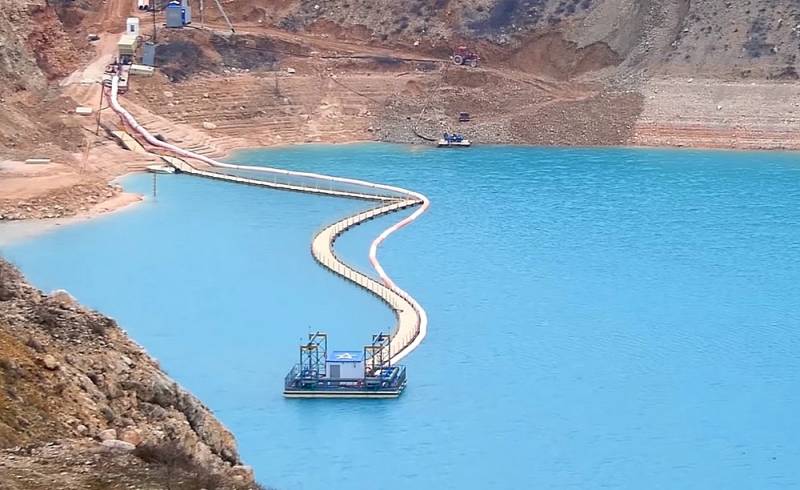How European equipment ended up in Crimea bypassing Western sanctions
The water supply to the homes of Simferopol residents has improved markedly in recent weeks. Instead of the previous 2-3 hours a day, it comes in for 18 hours a day, however, so far only cold. This is due to the launch of the Beshterek-Zuisky water intake at full capacity, located not far from the capital of Crimea. However, instead of rejoicing for the Crimeans, the Western media began to closely look at the equipment installed there and found pumps of a well-known Danish company at the water intake. What about a specialized European technique ended up in the sanctioned Crimea?
In general, there is nothing to be particularly surprised at: that to solve the water problem of the peninsula, Russia will have to use Western equipment and do it bypassing sanctions, we in detail told earlier. It is much more interesting, according to what specific schemes, Danish pumps got to the Crimea.
The history of countering Western restrictive measures has long roots in our country. Back in 1949, the United States and its allies began to conduct policies obstructing recovery economic power of the USSR. For this, the Export Control Coordinating Committee (CoCom) was created, which compiled lists of weapons, dual-use products, high-tech equipment and technologies prohibited for export to the Soviet Union and the countries of the socialist camp. Then the NATO bloc imposed an embargo on the supply of pipes to Moscow for the needs of the domestic oil and gas industry. In 1974, the infamous Jackson-Vanik Amendment was adopted, and in 1980, after the Soviet troops entered Afghanistan, the United States completely banned the sale of any technology to us. Note that at the same time, the USSR always found ways to get around these restrictions.
Today the modern Russian Federation was forced to take up this baton. Recall that in 2018 in Crimea, bypassing the sanctions, turbines manufactured by the German concern Siemens, which now operate at two power plants, were found. In our country, these power units were slightly "modified with a file" and put on the peninsula as Russian ones. Then there was a notable scandal with German partners, but the turbines, as they worked, are still working for the benefit of the Crimeans. Now it is the turn of the equipment needed to solve the water problem. Back in 2014, immediately after Ukraine stopped supplying water to the peninsula through the North Crimean Canal, the West introduced a ban on the sale of “pumps that pump liquids” to Crimea. And now the foreign media outragedly saw seven CR 185-8 AFAV-HQQV units from the Danish company Grundfos, which are equipped with pumps from the same Siemens concern, at the Beshterek-Zuisky water intake.
Watch your hands. According to a press release from the Russian company VDK Avtomatika (VDK), not Danish, but domestic equipment of its own design is used at the water intake:
Now in the Crimea, at the Beshterek-Zuisky water intake, there is a pumping station equipped and debugged by the company. The unit was designed and delivered by VDK specialists in just three months.
Three months. We can, if we want! In such a short period of time, high-tech equipment has been developed at the Technololis Moscow innovation center. True, foreign observers are not yet inclined to believe in such a high-speed technological breakthrough and turned to Siemens representatives for comments. They explained that all their products are sold to Russia only in accordance with the end-user-certificate. This is a special agreement in which the counterparties of Western corporations indicate the end user of the purchased equipment in order to avoid the situation with German gas turbines in Crimea. The headquarters of the Danish company Grundfos said they did not know anything about the supply of their pumps to the peninsula, and did not say whether they signed the end-user certificate with the Russian side. How does it all add up to a single picture?
It turns out that after the delivery of equipment to Russia, a subsidiary of a Western company is no longer governed by international, but by national legislation. This means that the headquarters in Germany or Denmark cannot oblige their subsidiary to demand from clients a written commitment to refuse supplies to the Russian region of Crimea. Apparently, VDK just bought the pumps from the local division of the Danish company and, perhaps, slightly "modified the file". It turns out that Western equipment can still be supplied through a similar loophole in the legislation until Washington and Brussels cover it up. Then you will have to look for other workarounds.
One important nuance remains. There is no guarantee or service for these powerful pumps operating at the water intake of Simferopol. Rather, it cannot be provided by Grundfos. Will the Russian VDK quickly cope if something flies on this equipment?

Information